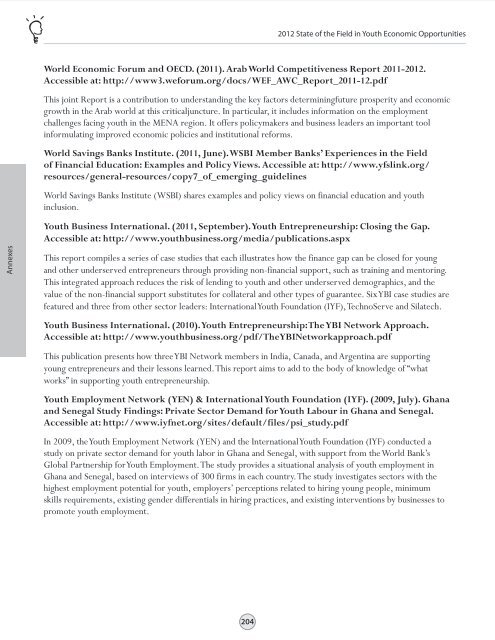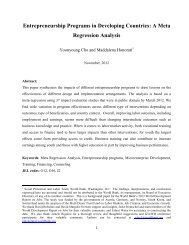STATE OF THE FIELD IN YOUTH ECONOMIC OPPORTUNITIES
STATE OF THE FIELD IN YOUTH ECONOMIC OPPORTUNITIES
STATE OF THE FIELD IN YOUTH ECONOMIC OPPORTUNITIES
Create successful ePaper yourself
Turn your PDF publications into a flip-book with our unique Google optimized e-Paper software.
Table of Contents<br />
Chapter 1 Chapter 2 Chapter 3 Chapter 4 Chapter 5 Chapter 6 Chapter 7 Chapter 8<br />
Chapter 9<br />
Chapter 10 Chapter 11 Chapter 12 Chapter 13 Chapter 14 Chapter 15 Annexes<br />
2012 State of the Field in Youth Economic Opportunities<br />
World Economic Forum and OECD. (2011). Arab World Competitiveness Report 2011-2012.<br />
Accessible at: http://www3.weforum.org/docs/WEF_AWC_Report_2011-12.pdf<br />
This joint Report is a contribution to understanding the key factors determiningfuture prosperity and economic<br />
growth in the Arab world at this criticaljuncture. In particular, it includes information on the employment<br />
challenges facing youth in the MENA region. It offers policymakers and business leaders an important tool<br />
informulating improved economic policies and institutional reforms.<br />
World Savings Banks Institute. (2011, June). WSBI Member Banks’ Experiences in the Field<br />
of Financial Education: Examples and Policy Views. Accessible at: http://www.yfslink.org/<br />
resources/general-resources/copy7_of_emerging_guidelines<br />
World Savings Banks Institute (WSBI) shares examples and policy views on financial education and youth<br />
inclusion.<br />
Youth Business International. (2011, September). Youth Entrepreneurship: Closing the Gap.<br />
Accessible at: http://www.youthbusiness.org/media/publications.aspx<br />
Annexes<br />
This report compiles a series of case studies that each illustrates how the finance gap can be closed for young<br />
and other underserved entrepreneurs through providing non-financial support, such as training and mentoring.<br />
This integrated approach reduces the risk of lending to youth and other underserved demographics, and the<br />
value of the non-financial support substitutes for collateral and other types of guarantee. Six YBI case studies are<br />
featured and three from other sector leaders: International Youth Foundation (IYF), TechnoServe and Silatech.<br />
Youth Business International. (2010). Youth Entrepreneurship: The YBI Network Approach.<br />
Accessible at: http://www.youthbusiness.org/pdf/TheYB<strong>IN</strong>etworkapproach.pdf<br />
This publication presents how three YBI Network members in India, Canada, and Argentina are supporting<br />
young entrepreneurs and their lessons learned. This report aims to add to the body of knowledge of “what<br />
works” in supporting youth entrepreneurship.<br />
Youth Employment Network (YEN) & International Youth Foundation (IYF). (2009, July). Ghana<br />
and Senegal Study Findings: Private Sector Demand for Youth Labour in Ghana and Senegal.<br />
Accessible at: http://www.iyfnet.org/sites/default/files/psi_study.pdf<br />
In 2009, the Youth Employment Network (YEN) and the International Youth Foundation (IYF) conducted a<br />
study on private sector demand for youth labor in Ghana and Senegal, with support from the World Bank’s<br />
Global Partnership for Youth Employment. The study provides a situational analysis of youth employment in<br />
Ghana and Senegal, based on interviews of 300 firms in each country. The study investigates sectors with the<br />
highest employment potential for youth, employers’ perceptions related to hiring young people, minimum<br />
skills requirements, existing gender differentials in hiring practices, and existing interventions by businesses to<br />
promote youth employment.<br />
204

















